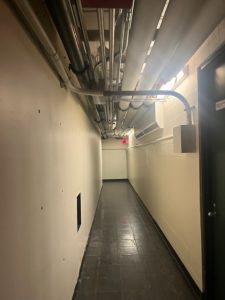The house next to my parent’s house is in the process of being demolished and rebuilt, and when they knocked down the old house, there was a huge pile of rubble that was then hauled away. I think that in the case of the house-rubble, viewing that waste as archive makes a lot of sense. That house, and the people who lived there, had a history. The people were part of our community, the house was part of our neighborhood, and I grew up with those things as a given, along with the other kids in my neighborhood. From an outsider’s perspective, viewing the scraps of wood and concrete, they wouldn’t know where the house had been or who had lived there, but it still has that history nonetheless. It could also easily be viewed as hazard, since most of the houses in my neighborhood were built during a time when asbestos was being used in construction, as well as the simple fact that there were pokey shards of wood and other potentially unknown hazards in the pile of debris. The construction and waste workers who were dealing with this debris wore PPE and took lots of precautionary measures to protect themselves from harm due to the nature of this waste, which seemed like a good call and made a lot of sense. This waste was also, in a lot of ways, a governable object, in that the house had been condemned by the government (deemed waste by the government even when it was still standing) and ordered to be demolished. It was under government supervision and following government regulations that the house was destroyed, the materials disposed of, and that the plans for the new house have started to be executed. The state had deemed the house either an eyesore or a hazard or both in its prior condition, and took steps to come in and change that. I think all three of these designations make a lot of sense when thinking about this house, but apply to different aspects of its existence and demolition process.
Fitting in a Filthy Bubble
When we think about Hoarding a lot of thoughts come up. Yes, it’s gross, hazardous, filthy, out of place, disgusting, ect. Just thinking of it makes me image clutters of items that eventually takes over someones home. A house with a persons with a hoarding disorder, is definitely living and breathing in a filthy bubble. Based on the reading, there is many ways that Moore’s conceptualizing of waste can be applied to hoarding. Although it give a mixture of positive and negative words about it, people who think it’s not a problem to hoard would use words like disorganized versus people who are against it that would use filthy.
Waste Responsibility
Building off a previous post, I consider clothing waste part of my responsibility in terms of making ethical decisions for its next destination. Clothing waste is heavily normalized in American society, and there’s also a stigma when it comes to second hand clothing. I feel like part of being responsible for your clothes is understanding the corrupt clothing industry filled with child labor and hazardous work environments, which helps you come to terms with your privilege. Additionally, I mainly consider it to be within my control when it’s in my possession, which can be a harmful way of thinking about waste. I think it’s a somewhat appropriate point to mark this division, however going back to the idea of knowing the ins and outs of your waste, can make you of proper consciousness.

Shit
A space that came to mind is the basement in the Dakin residences. The basement is filled with abandoned student spaces(spiritual life center), controls of heating and plumbing, and some trash. On the other side of the laundry area, there’s a room with a dumpster in it, and possibly a chute connecting it to the building above, followed by the expected artwork. Basements aren’t something you’d immediately associate waste with, unless you’re thinking of apartments and incinerators, so it was unique seeing that there. It’s interesting though, why is it there and closed off, where here at Hampshire waste isn’t something that’s being kept away from us. It’s in our bathrooms, common rooms, inside and outside academic buildings, dining commons, we’re even exposed to composted material. I’m curious what the purpose of that placement was for.

Responsibility and waste workers
In class we talked about the Peddle people and garbage industry and how peddle people has benefits of humanizing the waste workers to outside viewers. The waste industry is one often overlooked by most as a poor job and for those less fortunate, but with peddle people they work in their own time making as much money as their work load making for a more casual job and less competitive environment. We talked as a group on how peddle people are more approachable and enforce a sense of community and as a local business with different groups for each town meaning they are more flexible when there’s a complication. The reading showed the importance of the waste industry that is often seen poorly by outsiders.
Shit
Shit, whether you love it or not, is always around. The history of feces goes back as far as life on Earth itself. Every living creature, no matter how big or small, produces some form of waste. Surprisingly, feces has a range of uses. I remember a scene from the movie “Kickass” where they made explosives from manure. Initially, it seemed funny, but it’s a real thing. Personally, I’d rather use it for gardening, but some people have different ideas. In essence, the long-standing presence and adaptability of feces in the history of life highlight its constant nature and its diverse utility. Whether you find it interesting or not, feces have a consistent role in the natural world, and their uses vary widely, encompassing both humor and practicality. Its just a shame that people use it to harm others.
Matter out of place
In class we discussed how dirt and other products would disgust us if they were in the wrong place. If dirt was found inside a house we would try to get rid of it but if it were outside no one would really mind. This thought process comes from our need to organize and how things need to be in a certain place or it will be messy and contaminating. This affected me a lot in my past as my family is half Asian and as a tradition we are very strict about shoes and dirt in the house while the other side of my family did the opposite. This rule mostly stems from tradition though as of recently is seen as a necessary as covid and other diseases can find a way in through “dirty matter”. This lesson showed how we as humans are against any sort of dirt or trash that is completely normal in small quantities. Trash in our world is only ok in our eyes when it is out of sight in a trash can or in a dump.
Shit and waste
Natural waste is something we distance ourselves from since the stone age and even before that because the smell is built into us as a way to keep humans away from diseases. It was natural back then but since our expansion of the human race we needed to somehow reuse the waste we create or it is going to build up faster than anyway we can dispose of it. Our disgust for waste is shown in our marketing and design of buildings where bathrooms are hidden except for their signs. Waste product disposal often nicknames the waste in more pleasant terms to seem more inviting as a product to buy. This shows the distances we go to as a species to separate ourselves from something that we have to do pretty often. Especially since covid cleanliness has become a top priority and natural waste could not be a part of it and if it was it will be separated from those who produce it.
Hoarding
I’ve got quite a collection of boxes strewn around my home, despite moving in months ago. While it might seem like I’m stockpiling them to create a mammoth cat shelter, that’s not the case – at least not currently. The reason for these lingering boxes is mainly attributed to my struggle with depression, which has had a significant impact on my productivity. Cleaning them up has been a challenge because I’ve lacked the motivation to do so, and I also haven’t established a regular cleaning routine. So, it’s not about hoarding; it’s more about a combination of low energy levels and a lack of consistent cleaning habits that’s led to this situation. These boxes serve as a tangible reminder of my ongoing mental health battle, an issue that often makes even everyday tasks feel overwhelming. While they may clutter my living space, they’re a symbol of the broader challenges I’m working to overcome. In essence, my collection of boxes represents not a deliberate choice but a poignant reflection of the complex relationship between mental health, productivity, and daily routines.
Conceptualizing waste
An Object that I see often is the Plastic utensil, the one I will be using to day is a plastic fork. The fork is supposed to be single use and it is shown by not only the material it is made out of that is a brittle and flimsy plastic. The waste can be seen as an archive on a way how we eat and how we eat food now as this object is for eating on the go and one can assume when eating with a plastic fork it is for less fancy foods like meals stored in plastic containers for on the go eating. The waste is out of place due to being on the ground and not with a meal. It is also a commodity for the way we eat our meals for without it the meals would be messy. It is also a fetish for disorder as it is used as a sign of dignified eating but they seem to be found everywhere they are not “supposed” to be. Out of the readings I learned that an object as simple as a plastic fork can have a lot more behind it from its creation to what it is supposed to be used for and the amount of effort is put into this way of eating and after we are done with the fork we just dispose of it. The Amount of effort put into making shipping and selling into these forks just for them to be thrown away after one meal. This reading helped me digest the thought that our waste was important before being used.